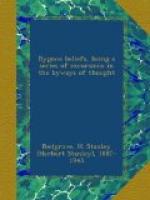To those who like to observe coincidences, it may be of interest that the septcentenary of the discoverer of gunpowder should have coincided with the outbreak of the greatest war under which the world has yet groaned, even though gunpowder is no longer employed as a military propellant.
BACON’S reference to gunpowder occurs in his Epistola de Secretis Operibus Artis et Naturae, et de Nullitate Magiae (Hamburg, 1618) a little tract written against magic, in which he endeavours to show, and succeeds very well in the first eight chapters, that Nature and art can perform far more extraordinary feats than are claimed by the workers in the black art. The last three chapters are written in an alchemical jargon of which even one versed in the symbolic language of alchemy can make no sense. They are evidently cryptogramic, and probably deal with the preparation and purification of saltpetre, which had only recently been discovered as a distinct body.[1] In chapter xi. there is reference to an explosive body, which can only be gunpowder; by means of it, says BACON, you may, “if you know the trick, produce a bright flash and a thundering noise.” He mentions two of the ingredients, saltpetre and sulphur, but conceals the third (i.e. charcoal) under an anagram. Claims have, indeed, been put forth for the Greek, Arab, Hindu, and Chinese origins of gunpowder, but a close examination of the original ancient accounts purporting to contain references to gunpowder, shows that only incendiary and not explosive bodies are really dealt with. But whilst ROGER BACON knew of the explosive property of a mixture in right proportions of sulphur, charcoal, and pure saltpetre (which he no doubt accidentally hit upon whilst experimenting with the last-named body), he was unaware of its projective power. That discovery, so detrimental to the happiness of man ever since, was, in all probability, due to BERTHOLD SCHWARZ about 1330.
[1] For an attempted explanation of this cryptogram, and evidence that BACON was the discoverer of gunpowder, see Lieut.-Col. H. W. L. HIME’S Gunpowder and Ammunition: their Origin and Progress (1904).
ROGER BACON has been credited[1] with many other discoveries. In the work already referred to he allows his imagination freely to speculate as to the wonders that might be accomplished by a scientific utilisation of Nature’s forces—marvellous things with lenses, in bringing distant objects near and so forth, carriages propelled by mechanical means, flying machines . . .—but in no case is the word “discovery” in any sense applicable, for not even in the case of the telescope does BACON describe means by which his speculations might be realised.
[1] For instance by Mr M. M. P. MUIR. See his contribution, on “Roger Bacon: His Relations to Alchemy and Chemistry,” to Roger Bacon Essays.




